Content:
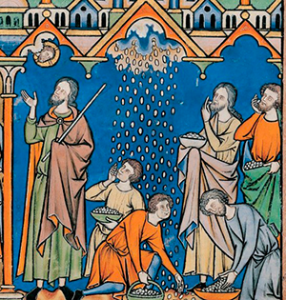 Thanks to the Old Testament, Manna from heaven has become in Christianity the personification of Divine grace and spiritual food. In folk usage it is a synonym of blessing. Manna from heaven also means unexpected help received at the right time and in abundance.
Thanks to the Old Testament, Manna from heaven has become in Christianity the personification of Divine grace and spiritual food. In folk usage it is a synonym of blessing. Manna from heaven also means unexpected help received at the right time and in abundance.
According to the Bible, Manna is the food that God gave miraculously to the Israelites during the Exodus. There are many versions of the Exodus from Egypt to the «Promised Land» under the guidance of Moses whose story with reed basket closely resembles the childhood of Sargon the Great, the founder of Akkadian Empire in Mesopotamia (the 3rd millennium BC) that is considered to be the first empire of the known history of mankind. Certainly, Sargon was a talented ruler. However, it is said that the actual force behind his success was Inanna, the «Queen of Heaven», the ancient Sumerian goddess of love, beauty, sex, desire, fertility, war, combat, justice, and political power. The Akkadians, Babylonians, and Assyrians later worshipped her under the name Ishtar. Sargon fulfilled her will, conquered new lands, suppressed insurrections and insurgencies. At that time, people and their rulers were often instruments of the policy of the so called gods, who had their own ambitions, scores and plans. See Inanna Returns by V. S. Ferguson.
There are many versions behind the real story of the Exodus. Some even claim that it was a special operation of the ancient Egyptian priests who were initiated into secrets of the structure of the power hierarchy on the planet.
Scientists still cannot explain the origin of the word «manna» and its exact meaning. Their attempts to find a rational explanation are vain. Manna is not the resin of the Tamarisk plant, a processed aphid or edible thallus of a special kind of lichen called lecanor. Moreover, it is not the juice of a camel’s thorn (suppressing the appetite) or, worse, a locust.
Manna was a gift from Heaven to the Israelites walking through the desert. It was a real miracle in the form of ready-made food, which must only be collected. Manna is described as edible white grains, reminiscent of the taste of honey. The order was to take as much manna as they needed to feed themselves. If someone disobeyed and collected manna in reserve, then it began to smell bad and worms appeared in it.
«And when the dew came to the camp at night, then manna also came down upon him». It was supposed to be collected every day (expected Saturday) by one homer (a measure of volume — about 3.5 liters) of manna per family member. Manna was abundant in the temporary dwellings of those who had a firm belief in God, and far from the tents of those who doubted.
The special meaning of manna is also indicated by the fact that it was stored in the Ark of the Covenant. The very word «manna» can be associated with the languages and heritage of ancient civilizations.
Perhaps the above mentioned mention of honey is also not by chance. In Hinduism, considered the most ancient religion of the world, 
and in the preceding «Vedas», honey is one of the five elixirs of immortality. In Sanskrit (literally «Divine Language»), the word «honey» is also connected with such terms as: sacred, mind, wisdom, life experience.
In Sanskrit, the word «mana» means «respect,» «idea,» «thought,» «base,» etc. It is the root of such 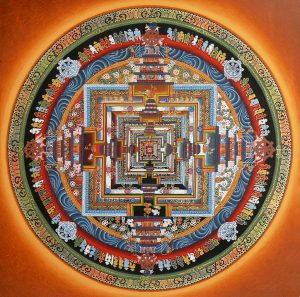 concepts as: «brain» and «high spirit» (manju), «precious stone» (mani), «counselor» (mantu), «sacred text, word or syllable» (mantra), «orbit of the celestial body» (mandala), etc. «Manati» means «remember, respect,» and «manata» means «proof.» The word «manasa» stands for «mental», «spiritual». These examples show the key spiritual meaning of the word and the root of «mana».
concepts as: «brain» and «high spirit» (manju), «precious stone» (mani), «counselor» (mantu), «sacred text, word or syllable» (mantra), «orbit of the celestial body» (mandala), etc. «Manati» means «remember, respect,» and «manata» means «proof.» The word «manasa» stands for «mental», «spiritual». These examples show the key spiritual meaning of the word and the root of «mana».
Most of the philosophical, religious, literary and scientific works of India are written in Sanskrit, including the oldest legislative book of Manu-smriti, which is included in the category of Holy Scriptures of Hinduism. This monument of ancient Indian literature is a collection of precepts to a pious Indian in the performance of social, religious and moral duty. The author is Manu, the legendary progenitor of mankind. The laws of Manu were an authoritative source of law in ancient India.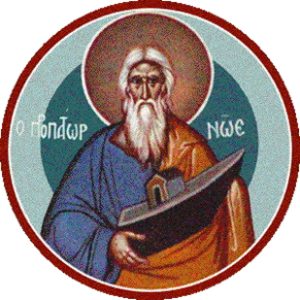
Manu is called «Indian Noah», although it can be the other way around. In the Old Testament the story of Noah came from the Middle Eastern epic rooted in the Sumerian and Akkadian heritage. The Harappan civilization, which existed in the III — II millennium BC on the banks of the River Indus, is one of the three oldest civilizations of the world, along with the Egyptian civilization of the first pharaohs (i.e. the time of so called gods) and Mesopotamia of the Sumerian era.
In ancient Indian literature, Manu was the son of the solar deity Vivasvata. Possessed with incomparable piety and wisdom, the great righteous in times of universal sin, Manu was the only mortal man saved by Vishnu from the Flood. After this, Manu became the first king to rule the Earth, the progenitor of the new human race.
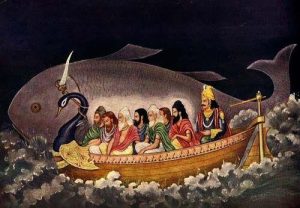 Vishnu appeared to Manu as a small fish, which sailed into his hands and asked to save its life. Manu put it in a pitcher. The fish grew. As a result, it grew to enormous proportions and revealed itself as Vishnu. It was Matsya (Sanskrit «Fish»), the first avatar of Vishnu, the keeper of the world, who repeatedly saved the human race from death. He warned Manu that there would soon be a Flood that would destroy all life. Vishnu instructed Manu to collect and put on the boat all varieties of plants and all kinds of animals to save them. When the Flood began, the great fish (Vishnu) sailed to Manu and attached the rope of the boat to its horn and in this way quickly headed for the northern mountain. This place is considered to be the Himalayas, in which the highest mountains of the planet are located.
Vishnu appeared to Manu as a small fish, which sailed into his hands and asked to save its life. Manu put it in a pitcher. The fish grew. As a result, it grew to enormous proportions and revealed itself as Vishnu. It was Matsya (Sanskrit «Fish»), the first avatar of Vishnu, the keeper of the world, who repeatedly saved the human race from death. He warned Manu that there would soon be a Flood that would destroy all life. Vishnu instructed Manu to collect and put on the boat all varieties of plants and all kinds of animals to save them. When the Flood began, the great fish (Vishnu) sailed to Manu and attached the rope of the boat to its horn and in this way quickly headed for the northern mountain. This place is considered to be the Himalayas, in which the highest mountains of the planet are located.
According to legend, on the site of the landing of Manu, today is the city of Manali. Together with him seven wise men, sons of the god Brahma, born from his mind were saved. They are considered the creators of the Universe and the ancestors of all living people. According to the names of these sages in Indian astronomy are called the seven main stars of the constellation Ursa Major. This constellation, together with the North Star, is depicted on the coat of arms of Alaska, which was part of Russian America. Another part of it
was presently famous Mount Shasta in California. Shasta is considered to be a mystic power 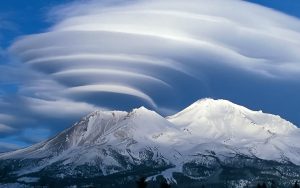 source for this planet. It is home of many the survivors of Ancient Lemuria, which sank under the waves of the Pacific Ocean a little over 12 000 years ago. Their language is Solar Maru, the root language for Sanskrit and Hebrew. They live in the subterranean city called Telos that serves as an inter-planetary and inter-dimensional portal. See Aurelia Louise Jones’ published books about Telos and the Lemurian teachings.
source for this planet. It is home of many the survivors of Ancient Lemuria, which sank under the waves of the Pacific Ocean a little over 12 000 years ago. Their language is Solar Maru, the root language for Sanskrit and Hebrew. They live in the subterranean city called Telos that serves as an inter-planetary and inter-dimensional portal. See Aurelia Louise Jones’ published books about Telos and the Lemurian teachings.
Manali («the abode of Manu») is located at an altitude of 2000 meters above sea level in the northern part of the sacred valley of Kullu, which has great religious and cultural significance. Kullu is still called the «Valley of the Gods». According to one version, the name «Manali» comes from «Manu-Ali», that is, «Manu doorway». Interestingly, «Gates of the gods» is the ancient names of the sacred for the Indians Haridwar and Babylon which greatly influenced the development of monotheistic religions (Judaism, Christianity, and Islam) that have shaped the modern world.
Manna (Mana) is an ancient state that existed in the 10th — 7th centuries BC in the territory of modern northwestern Iran. This place is


 called South or Iranian Azerbaijan. It consists of two provinces — Eastern and Western Azerbaijan, between which is Urmia — the largest lake in the Middle East and one of the world’s largest salt lakes. To the south and east of Lake Urmia is the historical core of the kingdom of Manna with a center in the modern city of Mekhabad. The Urmia is mentioned in Avesta, the main book of Zoroastrianism, the oldest of the revealed world-religions.
called South or Iranian Azerbaijan. It consists of two provinces — Eastern and Western Azerbaijan, between which is Urmia — the largest lake in the Middle East and one of the world’s largest salt lakes. To the south and east of Lake Urmia is the historical core of the kingdom of Manna with a center in the modern city of Mekhabad. The Urmia is mentioned in Avesta, the main book of Zoroastrianism, the oldest of the revealed world-religions.
There are many hypotheses about the meaning of Zarathustra’s name. One of them is «The Golden Sirius» that is sacral meaning of prophet’s name. Sirius is credited to be the Galactic Spiritual Center. Zoroastrianism had a remarkable influence on other world faiths: to the east on Hinduism and Buddhism, to the west on later Judaism, Christianity and Islam.
The first known people living in the territories around Lake Urmia (in the second half of the 3rd millennium BCE) are the cattle-breeding tribes of the Kutis. Presumably, they were of Indo-European origin. The Samaritans, resettled by Assyria in the territory of the former Israeli kingdom, are called «kutii». Manna also experienced a strong Assyrian 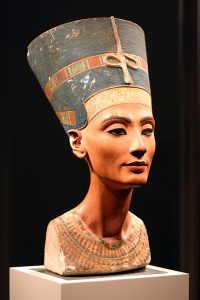 influence in foreign policy and architecture, which is its ultimate continuation. Another large ethnic component represented in the region of Lake Urmia were the Hurrians tribes. In the 16th — 13th centuries BCE, the Hurrians created the state of Mitanni in Northern Mesopotamia. In Mitanni were born the mother and wife (beautiful Nefertiti) of famous Egyptian pharaoh and reformer Akhenaton. The Hurrians exerted a strong influence on the Hittite kingdom whose double-headed eagle was notably used by the Byzantine Empire and later within the Christian and Islamic worlds.
influence in foreign policy and architecture, which is its ultimate continuation. Another large ethnic component represented in the region of Lake Urmia were the Hurrians tribes. In the 16th — 13th centuries BCE, the Hurrians created the state of Mitanni in Northern Mesopotamia. In Mitanni were born the mother and wife (beautiful Nefertiti) of famous Egyptian pharaoh and reformer Akhenaton. The Hurrians exerted a strong influence on the Hittite kingdom whose double-headed eagle was notably used by the Byzantine Empire and later within the Christian and Islamic worlds.
From the end of the 3rd millennium BCE the Lulubi tribes settled to the south-east of Lake Urmia. Their country of Lullubi constituted the main part of the later Manna kingdom. It is believed that the Lullubi predated the arrival of Iranian-speakers by many centuries. Presumably, the name «Lullubi» could be translated as «strangers» or «aliens». However, this is only the version. On the other hand, in the language of the state of Urartu, which covered the territory from Lake Van to Lake Urmia and from the Ararat Valley to northern Iraq, the word «lulu» meant «enemy-alien». Roots can be much deeper. For example, Nibiruans called people Lulu and actively used them in their clan wars, including in the above territories. The Lulubi tribes were a warlike people. They were not afraid to attack the powerful Akkad during the reign of the Akkadian king Naram-Sina, behind whome stood Inanna, the beloved granddaughter of Anu, then ruler of Nibiru.
The Manna kingdom began to form in the 10th century BCE from the descendants of the abovementioned kutis, hurrites, lulubies, etc. The main information about the kingdom comes from the inscriptions of the Assyrian and Urartian kings, who made military incursions into Manna. No inscriptions from the manneas themselves have survived to present time. The territory of their kingdom is still poorly researched archaeologically. An analysis of the history and events that took place here over the last three thousand years (from the time of the formation of Manna) leads to the conclusion about the special role of this territory, its key significance in the ancient sacred ties of modern Russia and Iran.
The first known ruler of Manna was Iranzu (740 — 719 BCE). He significantly strengthened the kingdom of Manna. It is symbolic that his name coincides with the name of the country. In translation, Iran means «the country of the Aryans». Arya is the mythical ancestor of the Aryans, mentioned in the sacred «Avesta». In the heart of Russia there are five rivers with name Arya. It is believed to be the birthplace of the ancestors of many Iranians and Indians.
There is a version that the above mentioned prophet Zarathushtra was born near modern Russian city Perm. Not 

by chance the word “permanent” starts from Perm. The city of Perm is twinned with Oxford, home to one of the leading universities in the world. Perm is  located on the bank of River Kama that is the greatest tributary of Volga, the longest river in Europe. The river flows through central Russia and into the mysterious Caspian Sea bounded by Iran on the south. Kama is the Sanskrit name of Indian god of love and desire. The Kama Sutra is the most known ancient texts among Sanskrit literature.
located on the bank of River Kama that is the greatest tributary of Volga, the longest river in Europe. The river flows through central Russia and into the mysterious Caspian Sea bounded by Iran on the south. Kama is the Sanskrit name of Indian god of love and desire. The Kama Sutra is the most known ancient texts among Sanskrit literature.
Modern genetic studies conducted by international experts reveal that that the common haplogroup have approximately 100 million Indian men (basically the Brahmans and Kshatriyas) and about 40-60 million Russian men. It means that they have a common male ancestor. So, they are brothers living in different countries. There is no data on Iran yet, but the proportion shall not be very different, given that the Aryans who came to India and Iran from the north (i.e. from the territory of modern Russia) were related by blood, language, culture, etc. The original homeland of the Aryans is Southern Siberia.
Like other regional kingdoms, Manna was largely focused on Assyria that was the most powerful. The process of formation of the kingdom of Manna and Assyria came about roughly at the same time (X century BC). They both reached the highest power at the same time (VIII — VII century BC). The decline of Manna started simultaneously with the weakening of Assyria, after the death of its last great king Assurbanipal. He is remembered in history not only as a skillful politician and the most enlightened man of his time, but also the collector of the largest library. He could read the ancient cuneiform texts that nobody could understand.
In 650 BC Ashurbanipal had to defeat the army of Manna and their allies Scythians (Saka or Saki), who settled between Manna and Urartu, passing from the shores of the Black Sea through the North Caucasus (modern Russia). Having received such support, Manna broke the alliance with Assyria and for a while became completely independent country with an independent foreign policy. The Scythians quickly passed through all of Mesopotamia, Syria, Palestine and reached the borders of Egypt.
Weakened by civil war, the Assyrian empire was destroyed by its rivals Media (northwestern Iran) and Babylonia (present-day Iraq) who shared the territory of the defeated power among themselves. On the ruins of the ancient Assyrian capital of Assur, the victorious kings concluded in 614 BC an alliance that was cemented by a dynastic marriage. The king of the Medes gave his daughter for the son of the Babylonian king. This fiance was Nebuchadnezzar, who later became one of the greatest rulers of Babylon. His father and commander of the Babylonian army was then also the famous Chaldean king Nabopalasar, also known in the Old Testament. In his younger years, he enlisted in the army of Assyrian king Ashurbanipal and rose to commander. Nabopalasar was appointed viceroy in Babylon. Taking advantage of the difficulties of Assyria, he rebel against it. Having had the support of the Babylonian priesthood as well as the trade and slave aristocracy, Nabopalasar was proclaimed the king of Babylonia in 626 BC. Thus he became the founder of the New Babylonian kingdom and the Chaldean dynasty.
In 610 BC, in Harran (southeastern Turkey), the Babylonians smashed the last of the Assyrian troops. In 590 BC the Medes (Media kingdom) occupied Manna. But it was not the finish of Manna.
It is known that after the absorption of Manna, it became the cultural and economic core of the Median kingdom, created by Iranian-speaking tribes. Another name (self-designation) of the tribes of the Medes is the arias (Herodotus). Iran means «The Land of the Aryans» (see above). The Medes gradually assimilated the above mentioned tribes of Kutis, Lulubeys, etc., from the earliest times inhabiting the territory of Iran.
Having began independent existence around 670 BC, Media completed it in 550 BC, when it was conquered by the Persian king Cyrus the Great who had the support of the aristocracy of Media. Via his mother, Cyrus belonged to their royal family and was the grandson of the Median ruler. Therefore, in the eyes of the rebellious Medes nobles, the victory of the Persians looked like a palace coup. The Persians were related to the Medes and were very close in language, religion, and customs. However, it is believed that Zoroastrianism was developed among the Medes more than among the Persians. The Median capital Ecbatana continued to be one of the capitals of the Persian, and later of the Parthian kings. Today this is city of Hamadan, one of the most ancient cities not only in Iran, but also in the world.
Cyrus the Great (600 – 530 BCE) managed to build one of the largest empires in history. It is equally notable for its very successful model of a centralized administration and establishing a government working towards the benefits of the people. Cyrus the Great respected the customs and religions of the lands he conquered. He is the only non-Jew who is called as Messiah. The Cyrus Cylinder discovered in the ruins of Babylon is called the first declaration of universal human rights. Alexander the Great was passionate admirer of Cyrus the Great. Having conquered most of the the huge Achaemenid Empire (founded by Cyrus the Great) Alexander took over the Cyrus’ model. Much of it was later adopted by the Soviet Union.
Mausoleum of Cyrus the Great is in the capital of his empire — Pasargadae. This mausoleum, along with the Mayan pyramid in 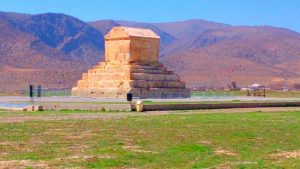 Palenque, served as an architectural prototype of Lenin’s mausoleum on The Red Square. Lenin
Palenque, served as an architectural prototype of Lenin’s mausoleum on The Red Square. Lenin 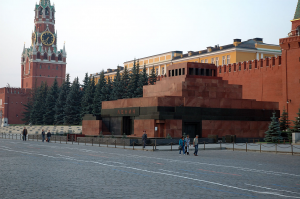 was the leader of the communist revolution, which in October 1917 abruptly changed the fate of Russia and the world. Like many key points of world history, Pasargadae stands on the 30th parallel. On this historic parallel also stands Persepolis, the second capital of the Achaemenid Empire. Cyrus the Great started building this new capital, but died before the completion.
was the leader of the communist revolution, which in October 1917 abruptly changed the fate of Russia and the world. Like many key points of world history, Pasargadae stands on the 30th parallel. On this historic parallel also stands Persepolis, the second capital of the Achaemenid Empire. Cyrus the Great started building this new capital, but died before the completion.
In 1941, during the World War II, by agreement with the British, the territory of the former Manna was entered by the Soviet Army. The leadership of Britain and the Soviet Union considered the Iranian Reza Shah a supporter of Nazi Germany. The Shah was overthrown and the Allies established control over Iran’s railways and oil fields. In 1942 Iran’s sovereignty was restored, the power was passed to the younger 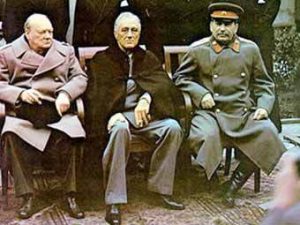 son of the Shah Reza, whose name is also present in Hara Berezaite. In 1943 Tehran hosted the famous conference of the leaders of the three allied states of the anti-Hitler coalition: Stalin, Roosevelt and Churchill. It addressed a number of issues of war and peace, including the opening of a second front by the Allies. The contours of the post-war arrangement were also outlined, and consensus was reached on issues of ensuring international security and lasting peace.
son of the Shah Reza, whose name is also present in Hara Berezaite. In 1943 Tehran hosted the famous conference of the leaders of the three allied states of the anti-Hitler coalition: Stalin, Roosevelt and Churchill. It addressed a number of issues of war and peace, including the opening of a second front by the Allies. The contours of the post-war arrangement were also outlined, and consensus was reached on issues of ensuring international security and lasting peace.
The planning of the Anglo-Soviet invasion of Iran in August 1941 was carried out under the leadership of the Chief of Staff of the Transcaucasian Military District, Major-General Fyodor Tolbukhin (1849 — 1949). He is regarded as one of the finest Soviet generals of World War II. Tolbukhin was well respected by fellow commanders and his soldiers, especially since he had a dedication to keeping casualty rates low. General Tolbukhin was the recipient of numerous awards and medals including the highest Soviet medal and rank, the Victory Order and Hero of the Soviet Union, respectively. As the highest honor, the urn containing his ashes was buried in the Kremlin necropolis wall. In his native land (25 km north of Yaroslavl), village of Tolbukhono is the most ancient settlement in Russia. His age exceeds 4000 years.
Tolbukhono stands on the lake of Tarasovo. In Sanskrit, «taras» means «energy,» «strength». Near Tolbukhino and the Tarasovo lake is the village of Sivtsevo. The root of its name can also be in Sanskrit. In Sanskrit, «siva» means «good», «bliss», etc. In the very center of Moscow there is a lane of Sivtsev Vrazhek. Here flows a small river Sivets or Sivka, enclosed in a pipe. Siva is the name of several rivers in the Urals, which is the oldest mountain range in the world. The highest point of the Urals is connected with great Indian sage Narada. Siwa is the name of the legendary Egyptian oasis, in which Alexander the Great went to risk his life to obtain confirmation of the divinity of his origin.
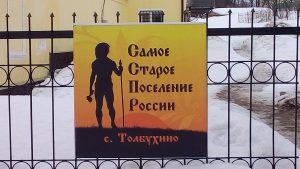

In 1516 the future Lord Chancellor of England Thomas More wrote «A truly golden little book, no less beneficial than entertaining, of a republic’s best state and of the new island Utopia». Utopia (the ideal country) was his idea of the best system of social structure on the example of a fictional island state. Thomas More wrote this book in his estate in Chelsea, which he called «a small utopia». Since 2003 the famous football club Chelsea has been owned by a Russian  businessman Roman Abramovich. The name Roman has ancient roots, like Abram (Abraham). In the Teachings of the
businessman Roman Abramovich. The name Roman has ancient roots, like Abram (Abraham). In the Teachings of the 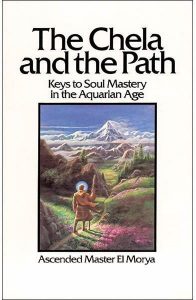 Ascended Masters, it is said that the patriarch Abraham, like Thomas More, was the incarnation of Mahatma El Morya.
Ascended Masters, it is said that the patriarch Abraham, like Thomas More, was the incarnation of Mahatma El Morya.
In the distant past, Ramano was the supreme deity of peace and quiet in Zoroastrianism. His memory day was celebrated on July 21. It is not only the day of the summer solstice in the Northern Hemisphere, but also the day of Procopius the Righteous, from whom the Russian Imperial Romanov family began. It is also the day of the Kazan icon of the Mother of God, the only Her icon that visited Cosmos.
The name Chelsea bears certain resemblance with the ancient word Chelas (students of a spiritual teacher). The mysterious Chelyabinsk meteor, whose largest fragment had weight over 500 kilograms, “made” a precisely round shape (about 8 meter in diameter) hole in the ice Chebarkul lake. It is against the law of physics. Moreover, it was the first case in history when large meteorites fall in a densely populated area. In the same Chelyabinsk region is the world famous Arkaim that was important spiritual center of the Aryans who later moved to Iran and India.
Known for his wit, Thomas More was called «the first person to embody the purely English ideal, according to which a virtuous person meets the enemy and the crisis situation not by silent obedience or arrogant statement of principle, but by joke».
